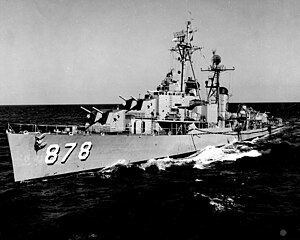USS Vesole

| |
| History | |
|---|---|
| Name | Vesole |
| Laid down | 3 July 1944 |
| Launched | 29 December 1944 |
| Commissioned | 23 April 1945 |
| Decommissioned | 1 December 1976 |
| Stricken | 1 December 1976 |
| Fate | Sunk as target, 14 April 1983 |
| General characteristics | |
| Class and type | Template:Sclass- |
USS Vesole (DD-878) was a Template:Sclass- of the United States Navy. She was named for Ensign Kay K. Vesole USN (1913–1943), killed in action during an air raid at Bari, Italy on 2 December 1943, and posthumously awarded the Navy Cross.
Construction and career
Vesole's was laid down by the Consolidated Steel Corporation at Orange, Texas on 3 July 1944, launched on 29 December 1944 by Mrs. Kay K. Vesole and commissioned on 23 April 1945.
Vesole alternated operations along the United States East Coast and in the Caribbean with the 2nd Fleet with deployments to the Mediterranean with the 6th Fleet, participated in blockade operations during the Cuban Missile Crisis in 1962, underwent an extensive Fleet Rehabilitation and Modernization (FRAM) overhaul at the Philadelphia Navy Yard in Philadelphia, Pennsylvania, in 1964, and during the Vietnam War served as plane guard for aircraft carriers on Yankee Station in the Tonkin Gulf, participated in Operation Sea Dragon and Operation Market Time, patrolled on search and rescue duties, and carried out naval gunfire support missions.
Vesole deployed in northern European waters from January to June 1969 as a participant in Standing Naval Force Atlantic (STANAVFORLANT), a NATO multinational squadron under a Dutch Commodore and Canadian Chief of Staff. During this cruise, Vesole made port calls at Den Helder, the Netherlands; Portland, Plymouth, Portsmouth, and London, England; Trondheim, Norway; Lisbon, Portugal; Funchal on Portugal's Madeira Island; Bermuda; and others. "Vesole" participated in Queen Elizabeth II's review of NATO ships in honor of NATO's 20th Anniversary. The STANAVFORLANT squadron incorporated American, Norwegian, Dutch, and British ships, as well as West German, Portuguese, and Canadian ships for a period.
From April to September 1970, Vesole deployed from its homeport of Charleston, South Carolina, to the Persian Gulf, Red Sea and Indian Ocean as part of the three-ship Middle East Force (USS Valcour, a converted seaplane tender as flagship) and two destroyers deployed on six-month rotations. En route from Charleston, Vesole made port/refueling visits to Bridgetown, Barbados; Monrovia, Liberia; Luanda, Angola; and Lourenco Marques, Mozambique. While attached to MIDEASTFOR, the two destroyers operated as single ship units. Vesole visited Mombasa, Kenya; Diego Suarez, Madagascar; Djibouti, then a French overseas territory; Asmara, then-Ethiopia; Bahrain; Bandar Abbas, Iran; Dhahran, Saudi Arabia; Karachi, Pakistan; Cochin, India; Colombo, then-Ceylon; Malé, Republic of the Maldives; and Victoria, Seychelles. The ship embarked Robert Strausz-Hupé, the American Ambassador to Ceylon and accredited to the Maldives for that nation’s fifth anniversary of independence. The Ambassador presented that country’s president with a moon rock from an Apollo program mission. Vesole returned to Charleston in October, with port/refueling visits in Lourenco Marques, Luanda, Dakar, Senegal; and St. John’s, Antigua.
Vesole was decommissioned at Charleston, South Carolina, and stricken from the Naval Vessel Register on 1 December 1976 and sunk as a target off Puerto Rico on 14 April 1983.
References
 This article incorporates text from the public domain Dictionary of American Naval Fighting Ships.
This article incorporates text from the public domain Dictionary of American Naval Fighting Ships.
